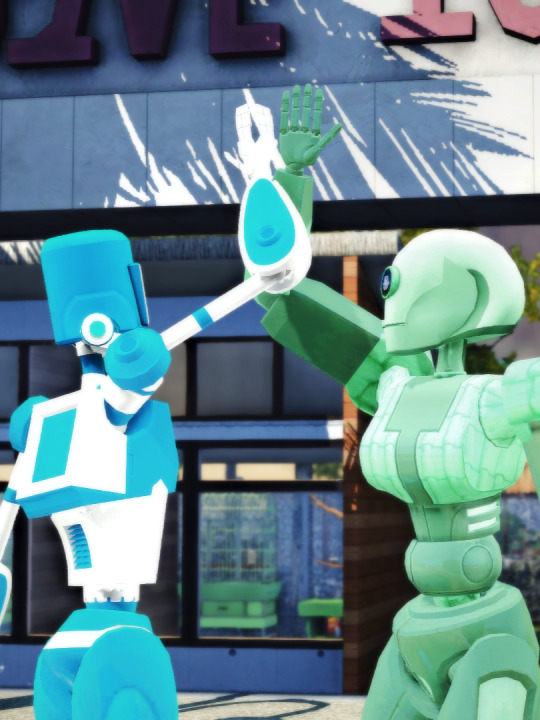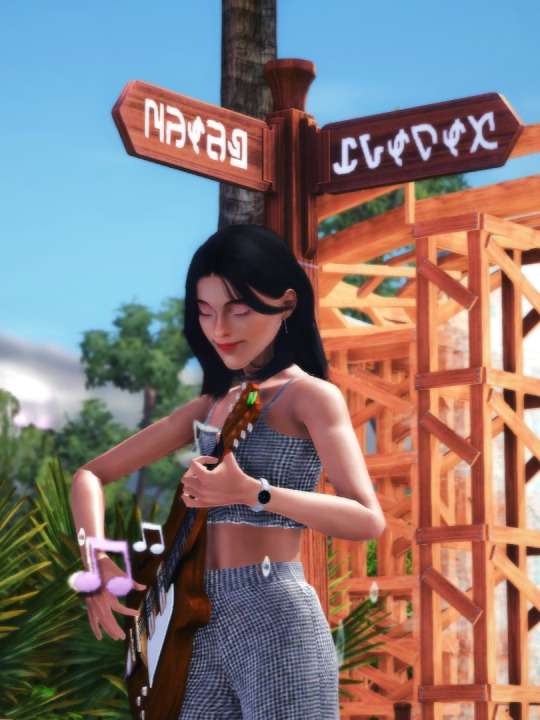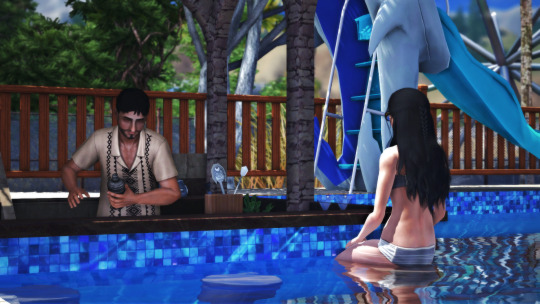#urban living
Explore tagged Tumblr posts
Text
Solarpunk Cities vs Solarpunk Villages

One of those internal contradictions of Solarpunk is, that Solarpunk loves at ones a very urban aesthetic, while also kinda loving the idea of rural living - just without all the rural people out there right now.
If you look at Solarpunk art, yes, you will see some art with skyscrapers overgrown with trees (that again, would not be happy on that skyscraper, do not do that to the poor tree!), a lot of art also shows small settlements surrounded by fields and such. Classical rural settings.
Now, when I posted a while ago about including rural living people into leftist causes, a lot of folks got quite angry with me over it. Because according to quite a lot of tumblrites, obviously everyone who lives rurally is inherently racist, sexist, and queerphobic, other than the queer people who had the bad luck being born rurally and cannot move. But everyone else! And because a lot of leftists have not quite understood the entire "class solidarity" thing, the general thought in those cases is not to talk to people, but to just "fuck them and leave them to die".
I will leave my disagreement with this on: "Yeah, actually, class solidarity is super important. Read up on it" for now, because I want to talk about mainly the advantages and disadvantages on either form of building a solarpunk society.
Cities have one major advantage: In a lot of ways they are a whole lot more sustainable. Which makes sense, if you think about it. Basically, in a city, a whole lot of people are living closer together, so building the infrastructure is just so much easier. You need so much less of everything to provide people who live in multi-household buildings with water, eletrcitity, heating and internet. Because you basically just need one accesspoint for everything to the building. And general in a city you will have a lot more multi-household buildings.
Even without those though: Population density is a lot stronger in cities. Duh. So even if everyone was living in a single-household home (which is not really the Solarpunk ideal) those are closer together and hence you still need less material and power to provide those things.
It is also easier to provide other types of infrastructure, such as schools, markets, and hospitals. Even stuff just like abilities to connect with other folks... It is just easier to do in a city than in a rural area.
However, a lot of Solarpunk is also about empowering people to grow their own food and such and be more self-sufficient. And this, obviously, becomes a lot easier if the people live in a less densely populated area.
Generally: Once you go out of the city - no matter how much you design the city planning around creating enough green spaces and such - you just will be closer to nature. It is a simple fact. You can more easily interact with nature, can more easily put out stuff like animals. And obviously it is easier to grow and cultivate all sorts of produce.
Don't get me wrong: Yes, we absolutely can create food forests in cities - but still, there is a lot more room in rural areas to cultivate food.
See, the main thing with Solarpunk cities is, that they still will not be fully self-sustainable. Yes, absolutely, we can cultivate some food in greenhouses, on rooftops and in foodforests - but it will not be enough to feed an entire city. Meaning: There will be people in rural areas, to grow and cultivate food.
Mind you, ideally we will absolutely bring down meat consumption. While I am not a big fan of the idea of a fully vegan future (for reasons I went into multiple times: some people can for chronic sicknesses, or disabilities not go fully vegan, and yes, I personally also see value in cultural stuff that involves meat), I do think we will eventually reduce meat consumption a lot. So we will need a lot less room to grow stuff - because right now a lot of vegetables (especially corn) are consumed by livestock. So reducing livestock will reduce the need for produce in many regards.
We can because of this rewild a lot of area that currently is used to grow corn and such.
Still. One way or another: some people will need to farm. The question is just how many. Because yes, we can automate a whole lot of stuff - but that brings us back to the good old question of us being alienated from our food. Sure, if we cultivate some food where people are, this might be better... But we definitely can philosophically discuss whether it would not be better for us as a species to always cultivate our own food. Especially as we know that food that is grown in mixed fields and under concepts of permacultre are a lot harder to harvest automatically - but much better for the environment.
So, some people will need to be out there for farmwork. The question just remains: How many?
Because exiling some folks from society to grow food and isolate them seems to be rather bad in taste too, right?
And there definitely is some arguments for some people living more rurally. It just is harder to create as a context.
And sure, if we ever got to the Solarpunk future, chances are, things will come to be naturally. However, it is still worth thinking about it and evaluating it.
#solarpunk#lunarpunk#rural living#urban living#urban landscape#city#village life#agrarian#agriculture#food forest#sustainable living#sustainable farming#infrastructure#city planning
47 notes
·
View notes
Text
by Jimmy Forsman, reality-inflicted.com
Daily original photographs and creations selected by the imiging team!

Another experiment with a hint of texture. Downloaded a texture pack on adobe (it was free) and just tweaked and pulled. Looks kinda nice. A way to simulate what a photo might look like when printed (I am looking at YOU Hahnemühle Albrecht Dürer).
35 notes
·
View notes
Text

Shady Grove Metro Center
Washington D.C.
Bob Cronk
#washington dc#metrorail#metro#shady grove#subway#bob cronk#bob cronk photography#nikon#urban architecture#urban photography#urban explorers#urban living#original photography#original photographers#photographers on tumblr#photography on tumblr#commuting
312 notes
·
View notes
Text

I have looked down the saddest city lane. I have passed by the watchman on his beat and dropped my eyes, unwilling to explain : Antonio Lopez, Glenda with Red Flower, 1977
#vintage style#vintage fashion#vintage photography#photography#photoshoot#minimal fashion#fashion#style#fashion campaign#photo#photooftheday#women's fashion#minimal aesthetic#minimalism#esthetics#aesthetics#trends#minimalistic#esthétique#urban#urban photography#urban fantasy#urban life#70's fashion#urban living#latino#fashion photography#fashion model#fashion inspo#fashion inspiration
265 notes
·
View notes
Text

.
#photographers on tumblr#original photographers#original photography#black and white#sunshine#summer#architecture#hamburg#shadows#windows#urban living#urban geometry
339 notes
·
View notes
Text

Fire escapes made good sleeping porches for the New York poor, such as this one on 11th St., August 30, 1948.
Photo: Tom Gallagher for the NY Daily News
#vintage New York#1940s#Tom Gallagher#fire escape#sleep#sleeping#summer#vintage summer#fire escape sleeping#Greenwich Village#urban living#brownstones
854 notes
·
View notes
Text


Day ends / © all rights reserved / htm.studios/2025/099
#photographers on tumblr#art photography#haluk turgut mengüç#artists on tumblr#©htm.studios#black and white#monochrome#landscape#interiors#htm.studios#day ends#fine art photography#urban living
44 notes
·
View notes
Text

Looking east out of our frosty front window at sunrise.
©cpleblow (2024)
(from back in january)
#cpleblow.tumblr.com#photography#photographers on tumblr#original photography#Colorado#cold winter#ice#frost#urban living
98 notes
·
View notes
Text

Urban Nights (Vessel) - Hudson Yards, New York City by Andreas Komodromos
#hudson yards#vessel#public art#nyc photography#nights#night photography#urban living#manhattan#city#nyc#cityscape#new york#urban#travel#new york city#nyandreas#architecture#urban landscape
95 notes
·
View notes
Text

bumped into a friend.
Shot with Kodak Gold 200.
#chicago#bikerlife#city bike#biker#biking#bikelife#aesthetic photography#street photography#streetlife#street#street portrait#street life#urban photoshoot#urban fantasy#chicago photographer#chicago style#aesthetic#urban photography#photographers on tumblr#analog photography#portrait photography#film is not dead#shoot film#kodak film#city life#city fashion#city folk#urban living#urban life#urban sprawl
84 notes
·
View notes
Text
Climate whiplash is already hitting major cities around the world, bringing deadly swings between extreme wet and dry weather as the climate crisis intensifies, a report has revealed.
Dozens more cities, including Lucknow, Madrid and Riyadh have suffered a climate “flip” in the last 20 years, switching from dry to wet extremes, or vice versa. The report analysed the 100 most populous cities, plus 12 selected ones, and found that 95% of them showed a distinct trend towards wetter or drier weather.
The changing climate of cities can hit citizens with worsened floods and droughts, destroy access to clean water, sanitation and food, displace communities and spread disease. Cities where the water infrastructure is already poor, such as Karachi and Khartoum, suffer the most.
Cities across the world are affected but the data shows some regional trends, with drying hitting Europe, the already-parched Arabian peninsula and much of the US, while cities in south and south-east Asia are experiencing bigger downpours.
The analysis illustrates the climate chaos being brought to urban areas by human-caused global heating. Too little or too much water is the cause of 90% of climate disasters. More than 4.4 billion people live in cities and the climate crisis was already known to be supercharging individual extreme weather disasters across the planet.
Rising temperatures, driven by fossil fuel pollution, can exacerbate both floods and droughts because warmer air can take up more water vapour. This means the air can suck more water from the ground during hot, dry periods but also release more intense downpours when the rains come.
“Our study shows that climate change is dramatically different around the world,” said Prof Katerina Michaelides, at the University of Bristol, UK. Her co-author, Prof Michael Singer at Cardiff University, described the pattern as “global weirding”.
“Most places we looked at are changing in some way, but in ways that are not always predictable,” Singer said. “And given that we’re looking at the world’s largest cities, there are really significant numbers of people involved.”
Coping with climate whiplash and flips in cities is extremely hard, said Michaelides. Many cities already face water supply, sewage and flood protection problems as their populations rapidly swell. But global heating supercharges this, with the often ageing infrastructure in rich nations designed for a climate that no longer exists, and more climate extremes making the establishment of much-needed infrastructure even harder in low income nations.
The researchers have worked in Nairobi, Kenya, one of the cities suffering climate whiplash. “People were struggling with no water, failed crops, dead livestock, with drought really impacting their livelihoods and lives for multiple years,” Michaelides said. “Then the next thing that happens is too much rain, and everything’s flooded, they lose more livestock, the city infrastructure gets overwhelmed, water gets contaminated, and then people get sick.”
Sol Oyuela, executive director at NGO WaterAid, which commissioned the analysis, said: “The threat of a global ‘day zero��� looms large – what happens when the 4 billion people already facing water scarcity reach that breaking point, and the food, health, energy, nature, economies, and security that depend on water are pushed to the brink?”
36 notes
·
View notes
Text

#photography#travel#photographer#landscape photography#my photos#original art#montreal#urban living#urban photography#my photography#my work
34 notes
·
View notes
Text

"Don't strive to be well known. Strive to be worth knowing." Alleyway, 2025 Taken by myself in Roswell, NM using a Canon Rebel T6
#photography#photographers on tumblr#amateur photography#original photographers#original photography#nature#nature photography#photographer#nature beauty#beauty#urban#urban photography#urban landscape#urban life#urban living#downtown#alley#city photography#city life#buildings#architecture#postoftheday#photooftheday#quoteoftheday#life quote#beautiful quote
32 notes
·
View notes
Text






#ts3#sims 3#ts3 gameplay#urban living#sim: Sienna Julian#sim: Leopold Schwartz#sim: Valencia Nguyen#sim: Yves
95 notes
·
View notes
Text

One paints the beginning of a certain end. The other, the end of a sure beginning.
#style#photooftheday#minimal aesthetic#minimalism#aesthetics#esthetics#photography#urban#everyday life#having fun#urban living#urban fantasy#drinks#drinking wine#having feelings#photo of the day#photo of the week#fashion inspo#je ne sais quoi#je ne regrette rien#urban life#summer vibes#summer aesthetic#summer 2024#summer nights#summertime#island life#island living
185 notes
·
View notes
